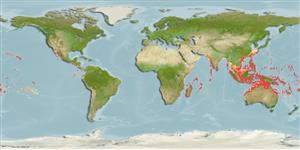Environment: milieu / climate zone / depth range / distribution range
Ecologia
marinhas associadas(os) a recifes; não migratória; intervalo de profundidade 5 - 135 m (Ref. 90102), usually 5 - 20 m (Ref. 58302). Tropical; 30°N - 30°S
Indo-Pacific: East Africa to the Galapagos Islands, north to Ryukyu and Hawaiian islands, south to Australia and the Tuamoto Islands.
Tamanho / Peso / Idade
Maturity: Lm ? range ? - ? cm
Max length : 10.0 cm TL macho/indeterminado; (Ref. 4313)
Espinhos dorsais (total) : 12; Raios dorsais moles (total) : 8 - 11; Espinhos anais: 3; Raios anais moles: 5 - 6. Tan to reddish or brown in color (Ref. 4313). Has prickly papillae instead of scales. Dorsal fin high, 3rd or 4th spine longest; suborbital ridge without spines or with lump at head of ridge; preopercle with 2 indistinct spines only; body extremely compressed; soft dorsal fin attached to the caudal fin; coloration is variable, from nearly all yellow to red, brown or nearly black and variously mottled with darker pigment (Ref. 10482).
Inhabits reef flats, outer reef slopes, current-swept channels, and rarely on lagoon reefs (Ref. 1602). Benthic (Ref. 58302). Solitary and usually immobile among algae or seagrass but effects hip movements resembling that of a leaf falling down from a tree. Molts twice a month with the skin breaking off first in the head region. Has the habit of mimicking a dead leaf by swaying from side to side (Ref. 37816). Feeds on small crustaceans and fishes (Ref. 9710); also feeds on larvae (Ref. 5503). Venomous spines.
Life cycle and mating behavior
Maturidade | Reprodução | Desova | Ovos | Fecundidade | Larvas
Myers, R.F., 1991. Micronesian reef fishes. Second Ed. Coral Graphics, Barrigada, Guam. 298 p. (Ref. 1602)
Categoria na Lista Vermelha da IUCN (Ref. 130435: Version 2024-1)
Utilização humana
Pescarias: espécies comerciais; Aquário: Espécies comerciais
Ferramentas
Relatórios especiais
Descarregue XML
Fontes da internet
Estimates based on models
Preferred temperature (Ref.
123201): 24.6 - 28.8, mean 27.5 °C (based on 566 cells).
Phylogenetic diversity index (Ref.
82804): PD
50 = 1.0000 [Uniqueness, from 0.5 = low to 2.0 = high].
Bayesian length-weight: a=0.01288 (0.00620 - 0.02676), b=3.03 (2.86 - 3.20), in cm total length, based on LWR estimates for this (Sub)family-body shape (Ref.
93245).
Nível Trófico (Ref.
69278): 4.1 ±0.68 se; based on food items.
Resiliência (Ref.
120179): Elevada, tempo mínimo de duplicação da população menor que 15 meses (Preliminary K or Fecundity.).
Fishing Vulnerability (Ref.
59153): Low vulnerability (10 of 100).
Nutrients (Ref.
124155): Calcium = 101 [50, 223] mg/100g; Iron = 0.85 [0.43, 1.95] mg/100g; Protein = 18 [16, 20] %; Omega3 = 0.287 [0.118, 0.837] g/100g; Selenium = 27.9 [13.5, 71.8] μg/100g; VitaminA = 304 [98, 890] μg/100g; Zinc = 1.41 [0.92, 2.11] mg/100g (wet weight);
